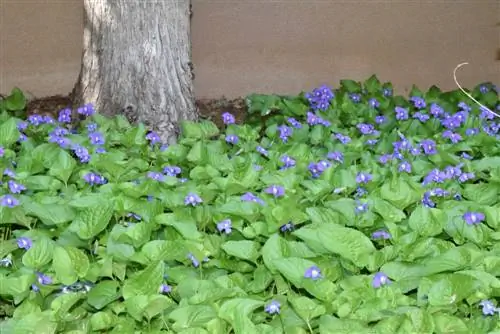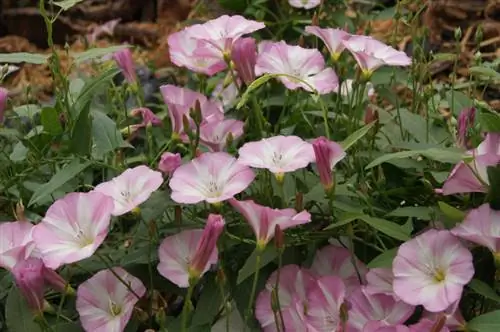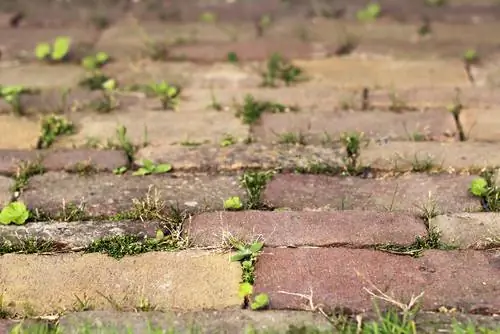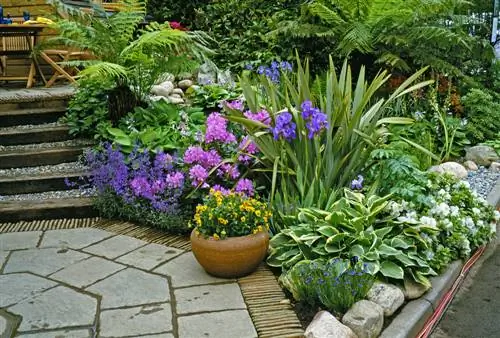- Author admin [email protected].
- Public 2023-12-16 16:46.
- Last modified 2025-06-01 06:02.
Inhibiting weed growth is one of the most popular uses of ground cover plants. They reliably cover large areas, are often quite decorative and also improve the soil. We'll show you how you can promote their weed-inhibiting effect.
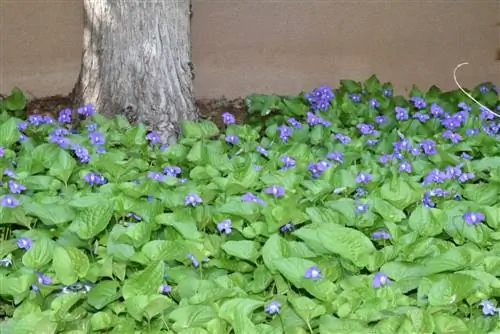
Which ground cover plants are suitable for weed control?
Densely growing, evergreen varieties such as goldenberry, elfin flower, carpet knotweed, ysander and ivy are suitable for weed control with ground cover plants. You should thoroughly clear the ground of weeds beforehand, keep the ground cover close and compact it if necessary.
What speaks for weed control with ground cover plants
It is not for nothing that ground cover planting is an established method of permanently greening otherwise bare areas in an easy-care way. The fast-growing species willingly form dense carpets of plants in flat areas that you can't or don't want to care too much about. Such areas could be:
- Path borders
- Wall stripes on the house
- Graves
- Embankments and free slopes
In addition to making gardening work easier, ground cover plants have other advantages in such places: They have a soil-strengthening effect, prevent surface erosion caused by weather influences such as strong wind or rain and at the same time activate soil life by continuously releasing moisture and converting fallen leaves into humus and provide nutrients for soil beneficial organisms.
With their often dense, assertive roots, they prevent annoying weeds from spreading in these places - and in a completely natural way. So ground cover can not only save you the strenuous Sisyphean work of weeding, but also the use of environmentally harmful herbicides or other harsh methods such as trimming.
Ground cover plants are also an ideal solution for planting under shrubs or trunks with sensitive root systems, under which weeds should not be removed by rough mechanical intervention. When cleverly combined with its carpet of plants, the ground cover gently ensures that no weeds grow up and instead offers an attractive substrate for tall plants.
Ground cover plants as weed inhibitors are recommended for many reasons:
- extremely reliable method
- saves a lot of work
- strengthens and improves the soil at the same time
- natural alternative to environmentally harmful weed killers
- gently keeping weeds away from root-sensitive tall plants
What needs to be taken into account when using weed-inhibiting ground cover
Although they have a reputation for requiring virtually no care and taking care of themselves and weed control, some ground cover plants do need a little help with weed work. Especially when you plant them for the first time.
Thorough weed removal before planting
Because even a vigorous, robust ground cover is not automatically assertive enough against stubborn weeds such as couch grass, groundweed or nettles in its starting phase. If you want to plant an area with a ground cover, it is important to prepare the ground carefully beforehand and completely remove all weeds and plant residues. This can be quite tedious, especially with weeds such as groundweed, which forms underground shoots.
In order to successfully establish the ground cover, the preparatory work is worth it. The more thoroughly you have cleaned the substrate, the less you have to expect weeds to emerge during the growth phase. Hoeing in the ground cover is not only taboo during the sensitive growth phase, but should also be avoided in principle. It damages the connected root system and can create unwanted gaps.
Keep ground cover close
So that the ground cover can permanently fulfill its weed-inhibiting task to your satisfaction, it is advisable to compact it through targeted pruning, especially in the first few years. If you leave it to grow on its own, it will form long shoots at the tips, so that larger and larger gaps form at the plant bases - this is where weeds sometimes have an easy time.
Shorten fast-growing shoots as regularly as possible in the initial phase - this will encourage the plant to sprout new shoots at the base and gradually thicken. Last but not least, this measure also makes the carpet of plants look much more well-groomed.
Suitable ground cover species to prevent weeds
Not all ground cover species are so vigorous and develop such a dense root system that they are suitable for targeted weed control. So choose varieties that grow as densely as possible, with roots, branches and foliage intensively above the ground. Examples of such varieties are:
- Goldberry - forms short runners, resulting in dense growth - bright yellow flowers
- Elf flower - very tough roots, no chance for weeds
- Carpet knotweed - flat-growing, pink spike flowers
- Ysander - very dense in all plant levels, pretty leaf structure
- Ivy - very vigorous, should be compacted as a weed inhibitor
What you should also note is that the long-lasting weed control effect improves with evergreen ground cover varieties. If they keep their shade-forming foliage even in winter, they can also put an end to particularly robust, cold-resistant weeds in the long term. Evergreen and densely growing varieties include:
- Ysander - extremely dense roots and decorative foliage
- Ivy - very robust, tried and tested classic
- Evergreen - hardy, but not quite as densely growing
- Elf flower - very dense roots
For gentle weed control under shrubs and trunks, ground cover plants with slightly less strong roots should be selected so that they do not suffocate the tall plants. Of course, they should also be able to cope with a semi-shady to shady location. Suitable varieties with slightly looser growth are:
- Storksbill - provides good shade, delights with its delicate flowers, is evergreen
- Foam blossom - particularly recommended under rhododendrons
- Spotted lungwort - less aggressive root system, pretty dotted leaves

